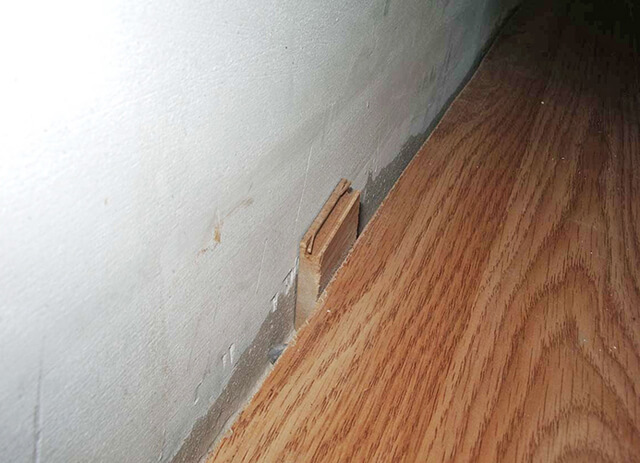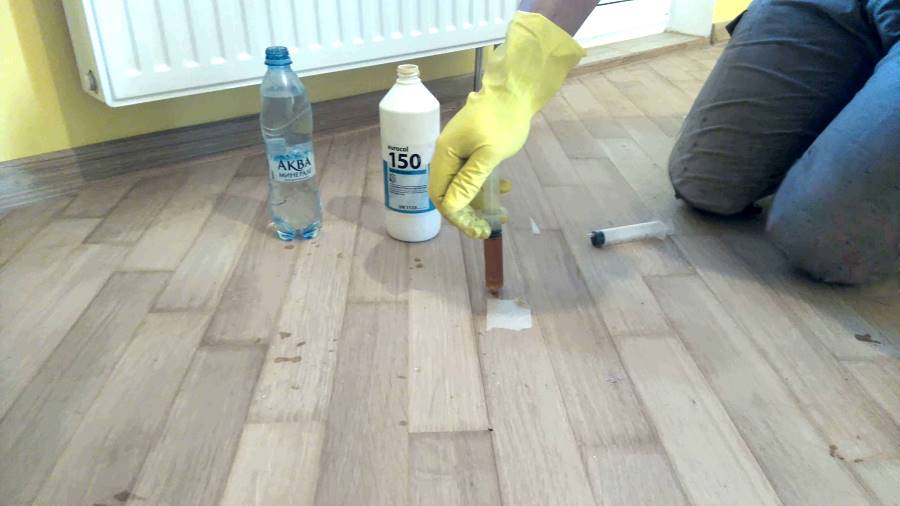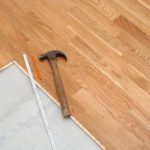Laminate flooring creaks
The creaking that appears immediately after laying the laminate is a natural phenomenon. Especially if the slats were installed without prior acclimatization at the installation site, the coating adapts to the microclimate of the room in about 2-5 days. But extraneous sounds after 1-2 weeks of operation are a reason to be wary. Perhaps they indicate mistakes made during preparation for installation.

The content of the article
Causes of squeaking
If the choice of laminate was made under conditions of a limited budget (a beautiful, but cheap and not certified product was chosen), then it is likely that the creaking in the apartment is associated with the incorrect geometry of the lamellas themselves - a characteristic feature of low-quality products. If there is a spare “board” left, you need to study it. Poor quality is indicated by:
- dirty green or dark brown color of the HDF board (the thickest inner layer);
- a simple lock with a single rounded groove;
- lack of information about the article, line, date and country of production printed on the reverse side.
If a combination of such signs is detected, you can immediately prepare for a complete replacement of the floor covering with a better one. It is impossible to eliminate the creaking of crooked laminate.
In the same case, when we are talking about products of trusted brands, extraneous sounds may indicate:
- insufficient size of compensation gaps;
- unevenness or destruction of the subfloor;
- presence of debris under the laminate;
- too thick substrate.
Each of the reasons is accompanied by a number of accompanying symptoms why laminate flooring creaks, on which methods for solving the problem depend.
Expansion gap
Fluctuations in temperature and humidity in the room are accompanied by expansion and contraction of the laminate. When laying the covering, this is taken into account - a gap is left between the edges of the lamellas and the wall, the size of which depends on the parameters of the room: from 1 cm for a small area to 3 cm for a large one, over 20 m2.

An expansion gap is left between the laminate and all “touching” surfaces. This means that it should also be between the covering and the elements protruding from the wall (the base of the arch, column, riser, etc.) since even point contact leads to a squeak.
If the requirement is not met, the swollen lamellas begin to press on each other, and the pressure on the locks increases. This is usually manifested by crackling when there is no load and a distinct sound when walking on the surface. In addition to creaking, it is possible to observe a “blowout” of the laminate - the appearance of a bulge along a long joint. If the necessary measures are not taken, the locks may break in this place, which will lead to the formation of an unsightly gap right in the middle of the room. What can be done:
- all furniture is removed from the premises;
- baseboards are dismantled;
- a visual assessment of wall gaps is carried out;
- if there is contact between the laminate and a vertical surface, it is necessary to cut off the ends of the coating at a distance of 1.5 - 2 cm from it;
- if there is a bulge, a “pressure” is placed on top of it - you can even use a simple board weighted with bricks (it is important to evenly distribute the weight of the load);
- After a control inspection of the gaps, the plinths are installed back.
After 48 hours, the laminate will return to a condition suitable for further use. This will be indicated by the absence of “waves” and creaking.
Base defect
If extraneous sounds have not disappeared a week after installation of the covering, this may indicate poor preparation of the subfloor. The fact is that after the finishing screed of the base it should be perfectly flat. Maximum tolerance: per 2 m2 no more than 2 mm deviation from the general horizontal level. If this rule is not followed, the “playing” lamella will transfer the load to neighboring locks, which leads to creaking.
In a situation where only individual elements of the coating “moan”, you can solve the problem without removing the laminate. In order to get rid of extraneous sounds, it is enough to drill a through hole in the problem area and through it using a syringe, insert PVA glue under the lamella (as much as will fit). After 2 days, during which you cannot step on the defective area, the composition will dry out and the squeak will disappear. All that remains is to mask the hole with a special grout for laminate flooring or wood putty of the appropriate shade.

If there are several “noisy” zones, then it will not be possible to fully solve the problem without dismantling the laminate. The only temporary way out of the situation is to treat the compounds with molten paraffin or wax. To do this, you will need a flexible spatula or an old plastic card, with which the applied substance is rubbed into the joint. But this method is applicable only when the creaking is not accompanied by crunching or noticeable bending of the lamella.
How to avoid problems
Most of the reasons that require disassembling the laminate to eliminate them are related to errors made during the installation of the coating. This:
- poor preparation of the base, on which unevenness remains;
- neglect of finishing, which in addition to leveling the subfloor also prevents its destruction;
- unscrupulous cleaning of the room before laying the laminate;
- incorrect choice of substrate, the thickness of which should not exceed 3 mm.
Sand and small construction debris cause a characteristic crunching sound. If the sound appeared immediately after installing the covering, then most likely there was debris left on the subfloor. When it appears after prolonged use, this may indicate that the destruction of the foundation has begun. In this case, 1-2 small problem areas are treated with PVA through drilled holes. But multiple or large areas will require preliminary removal of the slats.

A thick underlay is unable to compensate for uneven floors and remove sound. But under the influence of a short-term load, it collapses, recovering after the pressure decreases. The result is vertical deformation of the lamellas and squeaking with every step. It can be completely eliminated only after disassembling the laminate and replacing the substrate.





